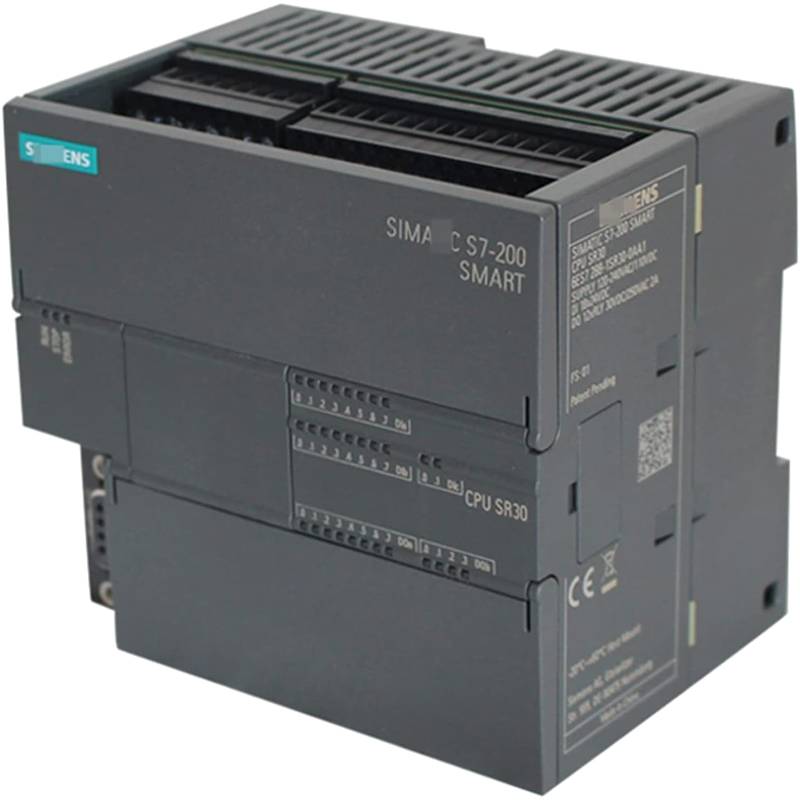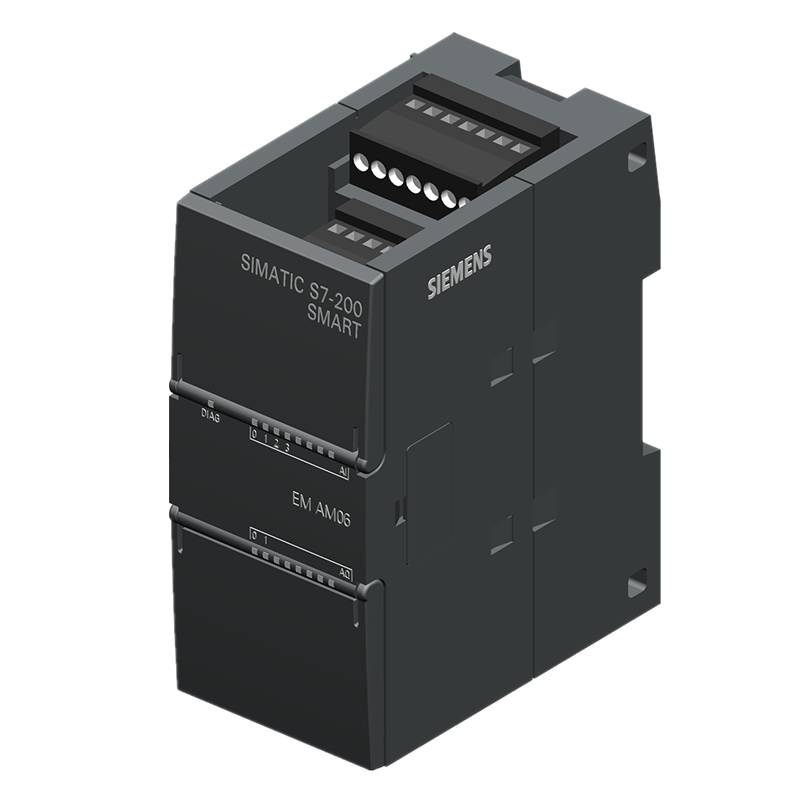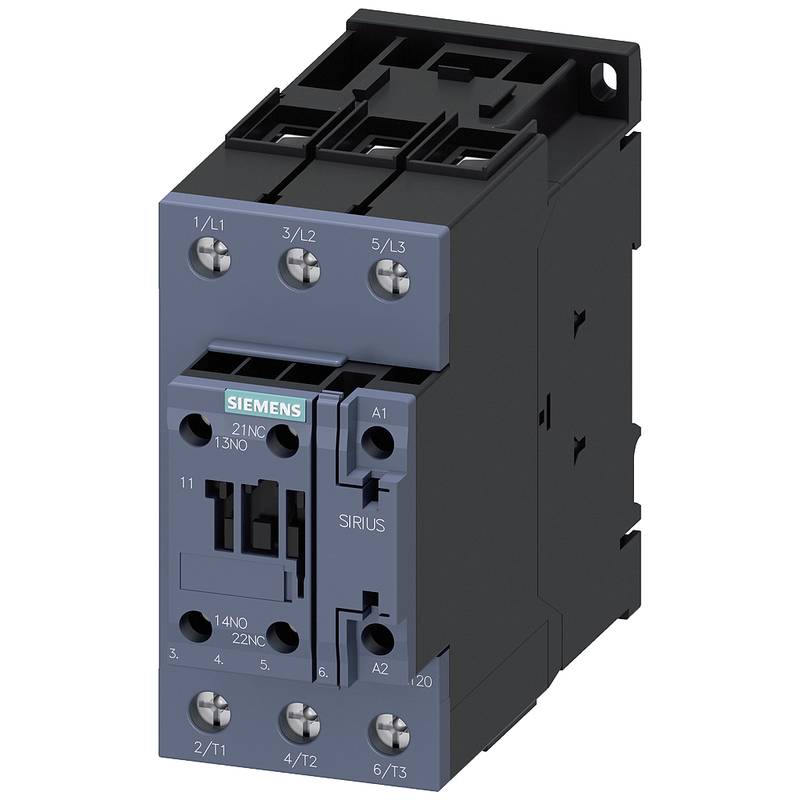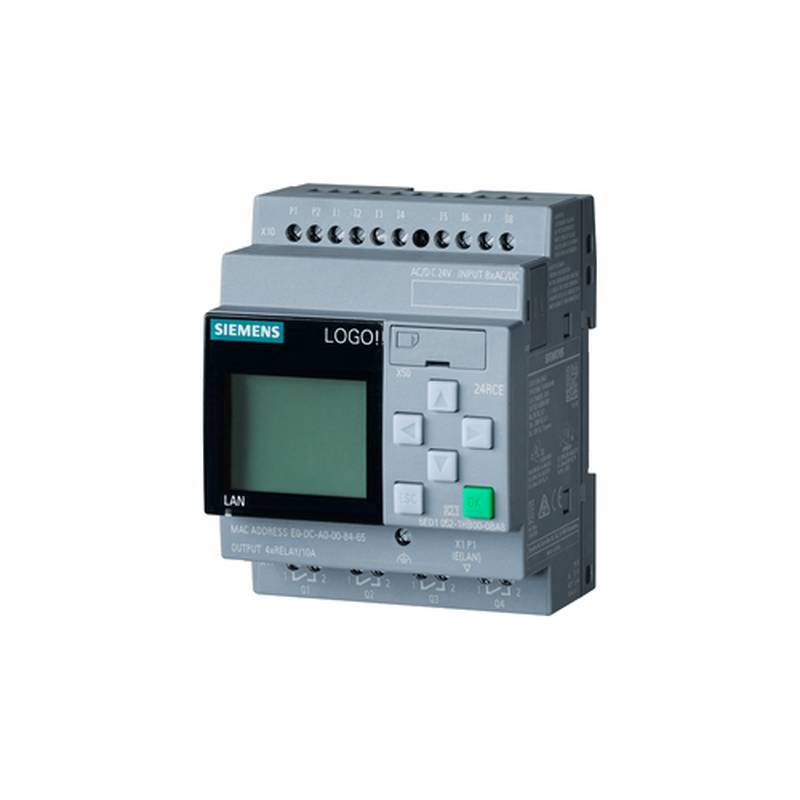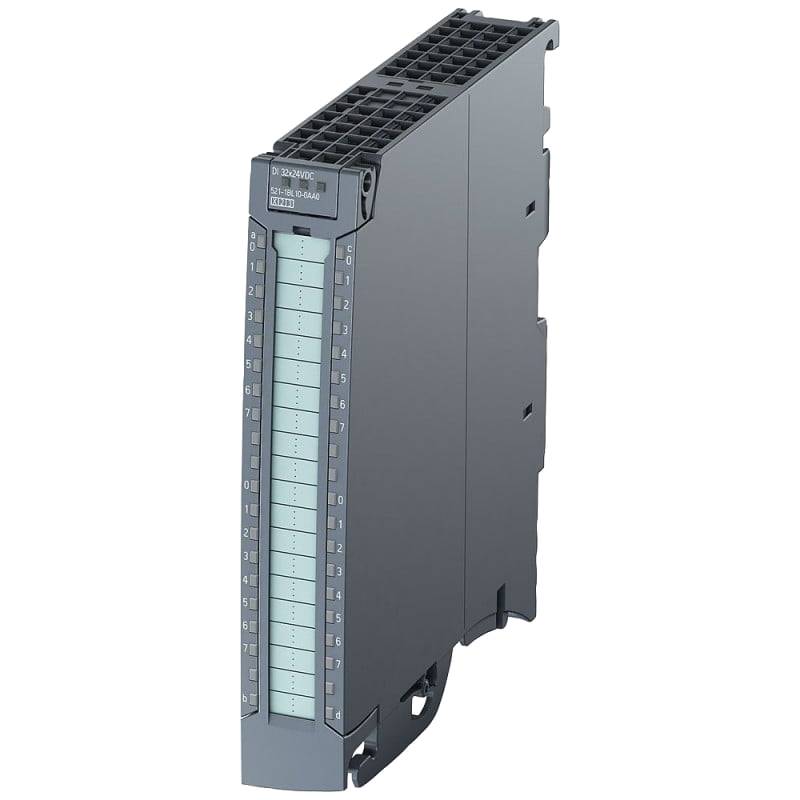
The Siemens 6ES7288-1SR30-0AA1 is a 16-point relay output module designed for integration into Siemens PLC systems, offering robust control capabilities for industrial automation. This module excels in applications requiring reliable switching of higher current loads and provides electrical isolation between the PLC and the controlled devices. Its key advantages lie in its durable relay contacts, suitability for diverse voltage and current loads, and seamless compatibility with Siemens S7-1200 and S7-1500 series PLCs. Critical technical parameters include 16 digital outputs, a 2A switching capacity per channel, a 24VDC input voltage, and standard DIN rail mounting.
Product Specifications
| Feature | Specification |
| :------------------------ | :--------------------------------- |
| Product Type | Relay Output Module |
| Siemens Order Number | 6ES7288-1SR30-0AA1 |
| Number of Digital Outputs | 16 |
| Output Switching Capacity | 2A per channel |
| Output Voltage Rating | 30 VAC / 24 VDC |
| Input Voltage | 24 VDC |
| Isolation Voltage | 500 V |
| Mounting | DIN Rail |
| Compatibility | Siemens S7-1200, S7-1500 PLCs |
| Operating Temperature | -20°C to +60°C |
| Dimensions (W x H x D) | Approx. 45 x 100 x 75 mm |
Core Features & Market Positioning
The Siemens 6ES7288-1SR30-0AA1 distinguishes itself through its inherent reliability and versatility, crucial attributes in demanding industrial environments. Its use of electromechanical relays provides a high degree of electrical isolation, safeguarding the PLC's internal circuitry from potential voltage spikes or back EMF generated by inductive loads. This makes it an ideal choice for controlling motors, solenoids, contactors, and other devices that may present significant electrical challenges. Compared to solid-state output modules, these relay outputs offer superior handling of surge currents and a wider operational voltage range, positioning it as a cost-effective and durable solution for many general-purpose switching tasks within Siemens automation ecosystems.
Key Application Scenarios
This relay output module finds extensive application across various industrial sectors. It is frequently employed in machine building for controlling actuators, pneumatic valves, and indicator lights on production machinery. In process automation, it manages pumps, valves, and alarm systems where robust isolation and switching capacity are paramount. The 6ES7288-1SR30-0AA1 is also well-suited for building automation, controlling HVAC equipment, lighting circuits, and access control systems. Its 16-point configuration provides ample capacity for moderately complex control schemes, making it a popular choice for standalone machines or sub-systems within larger plant-wide automation projects.
Practical System Integration Guidance
Integrating the Siemens 6ES7288-1SR30-0AA1 into a PLC system is straightforward, leveraging standard Siemens engineering practices. The module connects directly to the backplane of compatible S7-1200 or S7-1500 CPUs. Wiring involves terminating the field-side control signals to the screw terminals on the module, ensuring proper polarity for DC loads and correct phasing for AC loads. Each relay contact typically offers a Normally Open (NO) and a Common (COM) terminal. For programming, the module appears as a standard output byte or word in the PLC's I/O address space, allowing direct manipulation of the individual output points through ladder logic, function block diagrams, or structured text within Siemens TIA Portal.
Operation and Risk Mitigation
Proper operation of the Siemens 6ES7288-1SR30-0AA1 requires adherence to its specified electrical limits to prevent premature failure and ensure system safety. Exceeding the 2A per channel switching capacity or operating outside the rated voltage ranges can lead to contact welding, overheating, or premature wear. It is critical to correctly wire the loads, ensuring that any inductive components are fitted with appropriate suppression devices (e.g., freewheeling diodes for DC loads or RC snubber circuits for AC loads) to protect the relay contacts. In case of output failures, checking the specific PLC diagnostic buffer for error codes related to output module faults or field wiring issues is the first step in troubleshooting.
Scalability & Long-Term Value
The Siemens 6ES7288-1SR30-0AA1 offers excellent scalability within the Siemens TIA Portal environment. Its compatibility with the modular S7-1200 and S7-1500 platforms allows for easy expansion by adding more output modules as control requirements grow. This modular approach minimizes downtime during upgrades and ensures that existing investments in PLC hardware and software remain relevant. Furthermore, Siemens' commitment to backward compatibility and continuous platform development means that integrating this module into future IIoT and Industry 4.0 initiatives, such as data logging or remote monitoring, is streamlined through seamless integration with higher-level SCADA and MES systems.
Frequently Asked Questions
Q1: What is the maximum current rating for the Siemens 6ES7288-1SR30-0AA1?
The Siemens 6ES7288-1SR30-0AA1 module features 16 individual relay outputs, each capable of switching a maximum continuous current of 2 Amperes. This rating is crucial for selecting appropriate loads and ensuring reliable operation.
It is important to note that the total current across all outputs simultaneously should also be considered to prevent module overheating. Consult the datasheet for specific derating curves if operating at elevated temperatures or with many channels active.
Always ensure that the connected load's current draw does not exceed this 2A limit per channel to avoid contact damage or premature relay failure.
Q2: Can this module be used with non-Siemens PLC systems?
While designed primarily for Siemens S7-1200 and S7-1500 PLC systems, the 6ES7288-1SR30-0AA1 can potentially be used in other systems if they provide the correct 24VDC power supply and I/O signal compatibility.
However, integration with third-party PLCs would require custom interfacing and programming solutions, potentially negating the benefits of its seamless Siemens integration. This approach is generally not recommended for standard industrial applications.
For optimal performance, reliability, and ease of integration, it is strongly advised to use this module within its intended Siemens PLC ecosystem.
Q3: What type of loads can be controlled by the 6ES7288-1SR30-0AA1?
The relay outputs of the 6ES7288-1SR30-0AA1 are versatile and can control a wide range of AC and DC loads, including motors, solenoids, contactors, lamps, and heating elements. The 2A switching capacity is suitable for many common industrial devices.
Due to their electromechanical nature, these relays offer excellent surge current handling capabilities, making them robust for switching inductive loads. Nevertheless, it's still good practice to use suppression circuits for such loads.
Always verify that the voltage and current requirements of your specific load fall within the module's specified limits (30 VAC / 24 VDC, 2A) to ensure longevity and prevent damage.
Q4: How do I wire the Siemens 6ES7288-1SR30-0AA1 module?
Wiring involves connecting the 24VDC supply to the module's power terminals and then connecting the field devices to the individual output terminals. Each output typically has a common (COM) terminal and a normally open (NO) terminal.
For DC loads, connect the positive supply to COM and the load to the NO terminal, then the other side of the load to the negative supply. For AC loads, connect one line to COM, the load to the NO terminal, and the other line to the other side of the load.
Ensure all connections are secure and correct polarity is observed for DC circuits. Refer to the module's labeling or the TIA Portal I/O configuration for specific terminal assignments.
Q5: What is the difference between relay outputs and transistor outputs?
Relay outputs, like those on the 6ES7288-1SR30-0AA1, use physical contacts to make or break a circuit, offering high current capacity and electrical isolation. They are suitable for a wide range of AC/DC loads but have a slower switching speed and finite mechanical lifespan.
Transistor outputs are solid-state devices that switch electronically. They offer very fast switching speeds, high reliability for frequent switching, and lower power consumption but typically have lower current ratings and less electrical isolation.
The choice depends on the application: high power, diverse load types, and isolation needs favor relays, while high-speed, low-power applications favor transistors.
Q6: How do I configure the 6ES7288-1SR30-0AA1 in TIA Portal?
After physically installing the module, you need to add it to your PLC hardware configuration within Siemens TIA Portal. Navigate to the device overview, select your CPU, and add a new module in the appropriate slot.
Select the Siemens 6ES7288-1SR30-0AA1 from the hardware catalog. TIA Portal will then assign I/O addresses to the module's 16 outputs, which you can view and manage in the device's properties.
You can then use these assigned addresses in your PLC program (e.g., Ladder Logic) to control the output relays by setting the corresponding bits to TRUE or FALSE.
Q7: What are the operating temperature and environmental considerations?
The Siemens 6ES7288-1SR30-0AA1 is designed to operate reliably within an ambient temperature range of -20°C to +60°C (-4°F to 140°F). This broad range accommodates most industrial environments.
Avoid installing the module in areas with excessive dust, moisture, corrosive gases, or extreme vibration, as these conditions can degrade performance and shorten its lifespan. Ensure adequate ventilation around the module to prevent heat buildup.
Proper enclosure and environmental controls are essential for maintaining optimal operating conditions and ensuring the long-term reliability of the PLC system and its components.
Q8: Can I use this module for safety-related functions?
The Siemens 6ES7288-1SR30-0AA1 is a standard output module and is not typically certified for use in safety-integrated functions (e.g., emergency stops, safety gates). For safety applications, Siemens offers specialized safety relays and safety PLC modules.
Using standard components for safety functions can lead to non-compliance with safety standards and create significant hazards. Always consult relevant safety regulations and use certified safety components for all safety-critical operations.
It is crucial to differentiate between standard automation control and safety control and to select components specifically designed and certified for each purpose.
Q9: What is the typical lifespan of the relay contacts in this module?
The lifespan of the relay contacts is highly dependent on the application, specifically the switching frequency, load type (resistive vs. inductive), and the current/voltage being switched. Under normal operating conditions with resistive loads within specification, tens of thousands to hundreds of thousands of switching cycles can be expected.
For inductive or capacitive loads, or when switching near the maximum current rating, the lifespan will be significantly reduced due to arcing and contact erosion. Using arc suppression (e.g., freewheeling diodes, RC circuits) can extend contact life considerably.
Regular maintenance and monitoring of output status can help identify potential contact wear or failure before it impacts the process, allowing for planned replacement.
Q10: How does the electrical isolation benefit the PLC system?
The electrical isolation provided by the relay contacts prevents direct electrical connection between the PLC's low-voltage logic circuits and the higher-voltage or noisier field circuits. This protects the sensitive internal components of the PLC from voltage transients, ground loops, and electrical noise.
This isolation is critical when switching inductive loads (like motor coils or solenoids) that can generate significant back-EMF spikes when de-energized. Without isolation, these spikes could damage the PLC's output driver circuitry.
Furthermore, it simplifies wiring and troubleshooting by ensuring that faults or issues in the field wiring are less likely to propagate back and affect the PLC's core operation or other connected modules.














